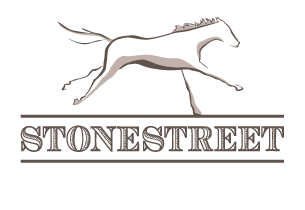Broodmares have been keeping everyone at the farm very busy since January, but new foals are not the only concern at this time of year. Over at our yearling division in Versailles, the new yearlings are ready for Spring Surveys and to perform them, our Yearling Farm Manager calls on the experienced veterinarians of Rood & Riddle Equine Hospital.
Surveys are radiographic examinations (aka x-rays) performed to identify the presence of Osteochondritis Dissecans (OCD) and small fragments. The ‘spring’ in spring surveys refers to the time of year the radiographs are performed. Surveys at Stonestreet Farm are taken when a horse is between 10-12 months old so the foals born in March and early April last year are currently being examined.
A lot of growing happens in the first year: A foal with mom and then at sale the next year.
During that year, their long bones have been growing and strengthening by laying down a smooth layer of cartilage on the growth plates, located near the end of the bone. As the flexible cartilage matures, it hardens into bone, adding length.
During this process, if the cartilage surface of the growing bone and the joint fails to develop properly, cartilage can be left at the surface, causing an OCD. The OCD is a split or separation of the cartilage surface that has a flap, loose flake or chip. Usually, the OCD will develop by the time a horse is 9 months old, but surveys are not suggested before 10 months.
The reason OCD’s exist is ultimately found in the naturally occurring development of the young horse’s bones. The interaction between many different factors can also impact the likelihood of development including: genetic predisposition, rate of growth, conformation, diet, level of activity, overall health, and management.
While OCDs may seem serious, in reality they are a common developmental issue that can be managed. The seriousness of an OCD depends on the size and location, but the majority will resolve naturally over time and have no effect on performance or racing potential.
It is important to remember that these flaps and chips are very small and measure in millimeters. Before surveys were performed using radiography, OCDs were not recognized without the presence of clinical signs.
OCD’s most frequently manifest in the stifle, hock, and fetlock, but can occur in all joints. Joint inflammation and various degrees of lameness are the most common clinical signs. Radiographs can be used to identify OCD’s before clinical signs occur and also to confirm the presence of OCD’s if clinical signs present themselves.
Radiograph being taken of the hock
One by one, yearlings are led from their stall to the center of the barn where the radiography equipment is set up. After the yearling is in position, a veterinarian and an assistant are able to produce images for each of the standard 36 views quickly.
Radiographs are taken of the hind legs at the fetlock, hock, and stifle joints and of the front legs at the fetlock and knee. The knee is radiographed while lifted and bent so that the joint is open, increasing the ability to spot any small abnormalities.
Consistent radiographs are important to guarantee the correct view of all joints. To ensure this, each yearling stands square with its weight distributed evenly.
Handheld radiography unit and radiograph
The veterinarian uses a handheld radiography unit with an assistant holding an imaging plate. This equipment shows the radiograph on a screen within seconds of each radiographic image giving the veterinarian the ability to make sure that all of the images are perfect before moving onto the next horse. Obvious issues are spotted while on location and all radiographs are inspected in greater detail when the images are reviewed back at the office.
Front leg is lifted to radiograph the fetlock joint
As soon as a veterinarian locates and reports an OCD or other abnormality, with his or her recommendation, our Yearling Farm Manager is able to decide the best course of action. While many will resolve over time, some may be arthroscopically removed. Keep reading our “How to Build a Racehorse” series to learn more about this minimally invasive surgery in the future.
Yearling surveys are supplied to the Repository for every yearling entered for sale by Stonestreet at a public auction e.g. Keeneland September, and must be taken within 21 days of the sale date. The Repository allows potential buyers to have a veterinarian view a specific horse’s radiographs at the sale prior to purchase. By performing Spring Surveys, we are able to see joint abnormalities earlier, preventing possible lameness or discomfort.
The abundance of data now available on OCD’s has shown that the majority are trivial once removed or healed and will not affect racing performance. With this knowledge, and the expertise of a veterinarian, buyers can now look at the overall horse without giving undue importance to OCD’s.
Radiography is the best way to check the joint health of all horses. Spring surveys will continue on throughout April as each yearling reaches the 10-12 month window discovering the presence or absence of any abnormalities. Either way, Spring Surveys make sure that every yearling is healthy and happy.
